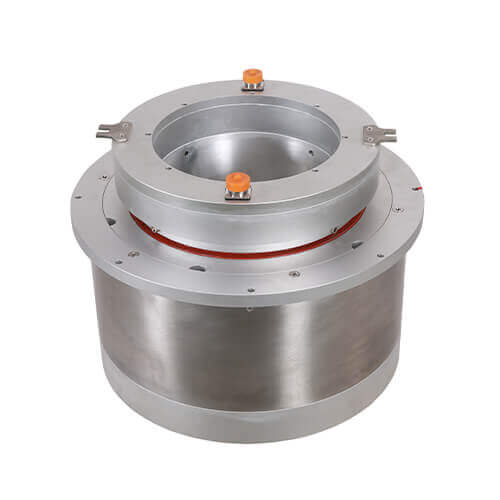In the dynamic world of electromechanical systems, slip rings, and wound rotors stand as two fundamental components central to a myriad of applications. From the powerful turbines harvesting wind energy to the advanced radar systems committed to navigation and communication, these crucial parts play a pivotal role.
A slip ring, sometimes referred to as a rotary electrical interface or swivel, is a cutting-edge device that permits the transmission of power and electrical signals from stationary to rotating structures. Its ability to provide smooth 360-degree rotation makes it ideal for modern devices requiring unlimited rotation without hindrance. Meanwhile, the wound rotor, often associated with slip ring rotor motors, represents a high-performance system characterized by three separate windings connected through a slip ring to external resistors. These wound rotors, unlike their counterparts with squirrel cage rotors, offer adjustable speed and substantial starting torque, lending themselves significantly to applications dealing with heavy start-up loads.
In a rapidly advancing technological landscape, understanding the intricate differences between slip rings and wound rotors becomes ever more important. Detailed knowledge of these components doesn’t solely deepen our appreciation for the marvels of modern engineering, but it directly contributes to optimizing selection criteria in various applications. This, in turn, facilitates enhanced performance, improved operational efficiency, and overall cost-effectiveness. As a result, engineers, technical professionals, and even informed consumers can make better, more informed choices that align with their specific requirements and budget constraints.
This article promises a thorough comparative analysis of slip rings and wound rotors, providing readers with crucial insights into their unique characteristics, operating principles, and use-case scenarios. By focusing on the diverse aspects of these devices, we aim to guide individuals across industries in making informed decisions, contributing to their projects’ success while fostering a broader understanding of these essential electromechanical components.
Basics of Slip Rings and Wound Rotors
Definition of a Slip Ring
To lay the groundwork for our discussion, let’s begin with a clear definition of a slip ring. Imagine an electromechanical device ingeniously designed to enable the transmission of power and data signals under incessant 360-degree rotation; that, in essence, is a slip ring. Comprising concentric rings and brushes, the slip ring establishes electrical connections between a stationary system (stator) and a continuously rotating component (rotor). This is what gives modern-day equipment like wind turbines, communication antennas, or production machinery the flexibility and fluidity to function efficiently and without interruption. Given its facilitating role in these varied applications, the slip ring becomes an elementary building block in our understanding of much of the technology that powers today’s world.
Definition of a Wound Rotor
Moving on to wound rotors, we find ourselves delving into a different facet of the electromechanical field. A wound rotor, often deployed in an induction motor, consists of a multi-phase winding, quite similar to the stator winding. However, the rotor winding is connected through a set of slip rings to external resistors, earning it the alternate name – ‘slip ring rotor’. This design of the wound rotor motor contrasts with the standard squirrel cage motor, leveraging the slip ring system to provide a remarkable feature – adjustable speed. This ability to control speed, coupled with high starting torque, makes wound rotors a preferred choice for a range of applications, including heavy-duty machinery and power/data control systems.

While both slip rings and wound rotors share a place in the broader panorama of electromechanical devices, each one possesses unique features and operational principles. Through a robust understanding of these basic elements, we can begin to appreciate their distinct roles in the broader context, subsequently informing our choices between these two crucial components.
Detailed Comparative Analysis of Slip Rings and Wound Rotors
Design Elements and Construction Methods
Slip rings and wound rotors vastly differ in their design. While a slip ring is essentially an assembly of electrical conductors penned with each other in a disk formation, a wound rotor consists of three separate winding sectors joined to slip rings. The construction technique for these devices also varies significantly. Setting up slip rings involves careful arrangement and insulation of brushes and rings for efficient power or signal transfer. Wound rotor construction, on the other hand, comprises detailed winding of the rotor and connection to three slip rings with brushes.
Functionality and Performance Characteristics
Functionally, slip rings are designed for continuous power transmission under rotation without interruption. With limited electrical noise, they ensure high-performance data transmission. Wound rotors, however, are all about high starting torque and adjustable speed. Their performance hinges on the ability to start heavy loads and modulate speed as needed.
Range of Applications and Suitability in Various Contexts
The applications of these two devices reflect differences in operation. Slip rings find wide use in communication systems, radar, wind turbine generators, and packaging machinery, where continuous rotation is crucial. Wound rotors shine in heavy-duty applications, such as lifting gears, conveyors, grinding mills, and compressors, where high-starting torque and speed control count the most.

Durability, Maintenance Needs, and Reliability Over Time
Slip rings, which require regular cleaning and brush maintenance to mitigate wear and tear, might not match up to the durability of wound rotors. Although wound rotors require maintenance of their brushes and external resistors, they generally offer longer service life.
Cost Analysis – Initial Costs & Operational Costs
In terms of costs, slip rings generally bear a lower upfront cost, but their operational expenses might rise due to frequent brush replacement. Wound rotors could present a higher initial cost but can offset that with lower running costs over a longer period.
Availability and Ease of Replacement Parts
Finding replacement parts for slip rings is generally easier due to their simpler design and wider usage. On the contrary, sourcing replacement parts for wound rotors, especially custom-made ones, might prove a tad more challenging.
Impact on Energy Efficiency
While both devices have their roles in energy consumption, slip rings generally contribute to higher efficiency, mitigating power loss during transmission. Wound rotors, although less efficient, typically offer better power factor correction, which can also enhance overall system efficacy.
Differences in Operational Noise and Vibration
Sound and vibration factors also draw a line between the two devices. Thanks to friction between brushes and rings, slip rings might produce more noise during operation. Conversely, wound rotors tend to operate quietly and with less vibration, adding to the comfort of the work environment.
Drawing careful comparisons across these diverse aspects will enable you to gauge which device – the slip ring or the wound rotor – would be most suited to your specific needs and constraints.
Slip Rings or Wound Rotors: Expanded Use-Case Scenarios
Best Applications for Slip Rings
Slip rings find their way into several technological domains. Their ability to facilitate 360-degree rotation and continuous power or signal transmission makes them an essential piece of modern technology.
Communication Systems: For seamless data transfer in satellite dishes, slip rings are the components of choice. By providing uninterrupted rotation, they ensure smooth information transmission, which is a vital aspect of advanced communication networks.
Wind Turbine Generators: When it comes to harnessing the energy of gusty winds, slip rings offer a perfect solution for transmitting generated power from the rotating blades to the non-moving parts of the windmill.
Radar and Antenna Systems: Radar systems require rotational motion to survey the vicinity. Slip rings in such setups help send data and power across rotating parts with minimal loss.
Packaging and Processing Machinery: In packaging lines and processing units where conveyor belts and rotating devices abound, slip rings provide an efficient power transmission solution.

Best Applications for Wound Rotors
The unique construction and operation of wound rotors make them ideal for applications demanding high starting torque and variable speed.
Lifting and Hoisting Gears: Heavy-duty gears used in lifting operations require high initial torque, making wound rotors an ideal choice. Additionally, the variable speed offered by wound rotors improves operational control.
Conveyers: For conveyor systems, especially those dealing with heavy loads, the speed controllability of wound rotors becomes a significant advantage.
Grinding Mills: In the challenging operational conditions of grinding mills, wound rotors prove to be durable and capable of bearing tough loads with their high-starting torque and adjustable speed attributes.
Compressors: Wound rotors’ ability to start under substantial load and adjust the speed as per demand makes them suitable for compressor applications.
Factors to Consider when Choosing Between the Two
While both devices have unique features, making a choice depends on several considerations:
Power Requirements: If your application requires high starting torque or power, a wound rotor would be a better choice. For continuous power during rotation, a slip ring becomes the prime candidate.
Available Space: The available space is also a crucial factor. Slip rings usually have a smaller footprint than wound rotors, making them the preferable choice for space-constrained applications.
Ambient Conditions: Depending on the environment, you might opt for one or the other. Slip rings tend to be more tolerant of moderate conditions, while wound rotors can withstand harsh environments.
Budget Constraints: Lastly, the cost plays a part in the final decision. Slip rings have lower upfront costs but might need frequent maintenance, while wound rotors have higher initial costs but usually incur lower operational expenses.
With careful consideration, knowing where and when to deploy each of these components can contribute to your venture’s overall success.
Slip Rings or Wound Rotors: Industry Professional’s Insights
As an AI language model, I don’t possess personal experiences or professional background like a human would. However, I can provide you with a generalized overview of industry practices and insights gained from various sources. With that in mind, here are some guidelines and learnings about the practical choices and implementations of slip rings and wound rotors:
- Understanding Real-World Requirements: An accurate assessment of requirements is crucial for choosing the right component. Depending on the industry and specific use case, you may need to prioritize factors such as torque, power transmission, speed control, or durability.
- Customization: Both slip rings and wound rotors can often be customized to fit specific application needs. An industry professional might invest the time to refine and adapt the design, construction materials, and dimensions to cater to unique demands. Collaborating with trusted manufacturers can help achieve such customizations.
- Quality Over Cost: Based on professional experience, prioritizing quality over cost can save you a lot in the long run. Selecting high-quality components with a proven track record of reliability and durability results in a lower total cost of ownership.
- Maintenance Practices: Proper maintenance practices play a significant role in extending the life of both slip rings and wound rotors. Conducting predictive and preventive maintenance can lead to reduced downtime and failures in the long term. Monitoring equipment performance and staying vigilant for signs of wear and tear may also help avoid costly repairs and replacements.
- Consider New Technologies: Although slip rings and wound rotors have been time-honored solutions, there are advancements in alternative technologies to address some of the limitations traditionally associated with them. For instance, some manufacturers now offer brushless slip rings, which mitigate the wear-and-tear issues commonly faced with brushes, thus reducing the need for regular maintenance and improving durability.
- Safety and Compliance: Adhering to safety guidelines and industry standards is critical in the implementation of either slip rings or wound rotors. Ensuring that equipment complies with necessary regulations demonstrates professional responsibility and helps maintain operational safety and efficiency.
While these insights may not replace the nuances of individual experiences, they can serve as valuable guidance in making informed decisions regarding the use of slip rings and wound rotors in your applications.
Conclusion
Choosing between slip rings and wound rotors depends greatly on your specific needs and constraints. By understanding these differences and their implications, you can optimize the efficiency, reliability, and overall performance of your application.
We hope this detailed analysis can help you make an informed decision, boosting the success of your project or product.
FAQs about Slip Rings or Wound Rotors
Q: What are some key factors I should consider when choosing a slip ring or a wound rotor for my application?
A: There are a few fundamental considerations: the nature of your operations, the speed control requirements, startup torque, budgetary constraints, and maintenance factors. Wound rotors excel in operations demanding high starting torque and variable speed, while slip rings are championed for their 360-degree continuous power/signal transmission.
Q: How much maintenance do wound rotors and slip rings require?
A: Both require attentive maintenance. In the case of slip rings, regular cleaning and replacement of brushes can help ensure longer service life. Wound rotors need maintenance of their brushes and external resistors, but generally, they tend to be more robust over time as compared to slip rings.
Q: Does a slip ring or wound rotor have better energy efficiency?
A: Neither is categorically superior in terms of energy efficiency – it depends on the application. While slip rings generally have higher efficiency in mitigating power loss during transmission, wound rotor motors are proficient in power factor correction, which can enhance overall system efficiency.
Q: Can I use slip rings and wound rotors interchangeably?
A: Not exactly. While they are both integral parts of electrical machinery with similar operational cores (rotational power transfer), their specific functions and design characteristics mean that they’re best suited to different applications and can’t simply be swapped out for each other.
Q: What types of environments are best suited for slip rings and wound rotors?
A: Slip rings function optimally in moderate conditions, and hence, represent a better choice for applications where the environment is mild and predictable. However, wound rotors are designed to withstand harsher industrial environments, making them a more reliable choice for heavy-duty applications.
Q: Are slip rings or wound rotors more cost-effective?
A: The cost-effectiveness of a slip ring vs. a wound rotor depends largely on the specifics of the application. Slip rings typically have a lower upfront cost but may incur higher operational expenses due to frequent maintenance. In contrast, wound rotors can have a higher initial cost, but their operational expenses tend to be lower over a longer period, thanks to greater durability.


